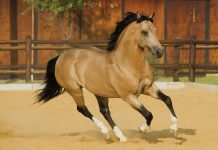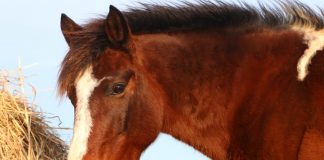Have you noticed that your hands and feet are taking less time to thaw out after you hop off your horse? And after you groom your fuzzy friend, do you end up covered from head to toe in hair? This can only mean one thing—spring is finally here!
But before you saddle up your horse and start enjoying the warmer weather, you should take care of a few simple chores. You’ve got some spring cleaning to do.
Check out our tips to help your horse be happy and healthy in the spring and summer months.
Fly Control
You’re not the only one who starts being active when the snow melts and temperatures warm up. Flies start buzzing in the spring, so it’s important to protect your horse from them.
Don’t leave large piles of manure around your horse’s stall or pen, especially if it’s wet. Flies like to breed in damp places. If they can’t breed, then you won’t have as many.
Set up fly traps near your horse’s stall and put fly spray on your horse when you go out and visit her. You can also get her a flysheet. The mesh material keeps flies off her and helps keep her coat from fading when she’s turned out. You can also get her a fly mask to protect her eyes. Try to check under the fly mask and flysheet every day to make sure there aren’t any cuts or bruises.
Dewormers
A regular deworming schedule is vital for your horse’s health. Worms and dangerous parasites thrive in warm and moist conditions. You definitely don’t want your horse to get worms, so remember to deworm in the spring. It’s easy to forget when you last dewormed your horse, so write down the date you deworm your horse on a calendar. Ask your veterinarian about what kind of dewormer to use.
Mud
Spring usually means rain, and when you’re at the barn, rain means mud! Horses are likely to be standing in mud when they’re near water troughs, but it’s not healthy for their hooves to be wet all the time.
If your horse spends a lot of time in a muddy pasture, she could get thrush, a bacterial infection in her hoof that smells bad and leaves black material in the hoof. The best way to protect your horse from thrush is to pick out her feet daily.
Mud fever is another bad side effect of mud. When wet, sticky mud stays on the backs of horses’ legs for long periods of time, bacteria can start to grow. If the mud isn’t washed off, horse’s legs can become swollen and scabby.
Fresh Green Grass
It’s likely that your horse doesn’t get as much green grass during the winter months as she does during the summer. It’s nice to see your horse munching on the lush, green grass in his pasture in the spring, but you may have to limit his grazing time. High amounts of sugar in fresh grass can be unhealthy for some horses and may cause founder, a condition that causes inflammation in the hoof and may result in the horse’s cannon bone separating from the hoof wall. Founder is very painful for a horse and can cause permanent lameness.
All that new grass can also upset your horse’s digestive system and give her diarrhea. If your horse hasn’t had any grass during the winter months, give her some hay before you turn her out into pasture. However, your horse won’t need as much hay in the spring and summer as she did in the winter months.
Blankets
If you had a blanket on your horse during the winter, it’s probably got lots of mud on it. Once spring comes, it’s easy to put the blanket in a corner of the tack room and not think about it until winter, but that’s a bad idea.
Have your blanket cleaned. A dirty blanket that has any moisture on it could grow mold, and you don’t want mice or rats to make a home in it. Once you’ve had your blanket cleaned, put it in a waterproof container. You never know when rain could come through a tack room roof or a hose could accidentally spray your belongings. A blanket is an expensive item–take care of it so it’ll be able to keep your horse warm and toasty next winter.
Shoes
If your horse is barefoot or if you pulled her shoes for the winter, it’s time to call the farrier again. Even if you plan on keeping your horse barefoot, she probably needs a trim so she can be comfortable when you go on rides.
Remember that your horse’s feet may be tender when you start riding again. If you put shoes back on her, give her several days to adjust to the feeling. You wouldn’t want to go for a long run in shoes that aren’t broken in, and your horse won’t want to go for a ride if her feet are sore.
Spring Makeover
If you didn’t show your horse during the winter months, she’s probably quite fuzzy! When you get ready to start riding again, give your horse a makeover. After you give her a warm bath, let her dry completely. Then grab a pair of clippers, have a friend hold your horse and start tiding up. Clip her bridle path, but remember not to make it too long. Some breeds have longer bridle paths to accentuate the neck. If you show under a specific breed, check the breed association’s guidelines. You’ll also want to clip her muzzle, ears, chin and fetlocks.
If you show English, you can bang your horse’s tail. Banging a horse’s tail means that you make a blunt cut at the bottom, to make it look more thick and luxurious.
Lesson Time
Lessons can be difficult in the winter, especially if you live where there is a lot of snow and ice. Spring means you can call your instructor and ask when lessons start. It may take several weeks for you and your horse to get back in shape. Be patient so you don’t make yourself or your horse too sore.





